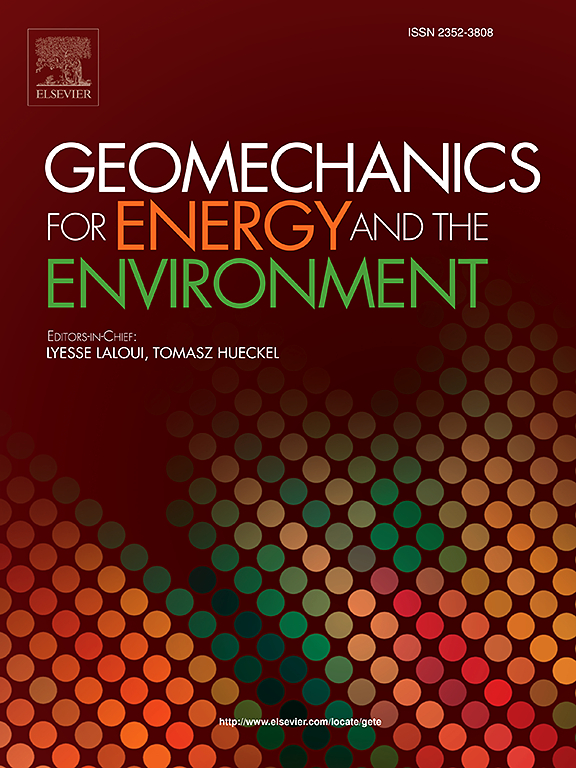Quantitative prediction of tertiary formation fractures and its application in lost circulation prediction in the Bozhong Depression
IF 3.7
2区 工程技术
Q3 ENERGY & FUELS
引用次数: 0
Abstract
In recent years, the exploration and development of oil and gas reservoirs in the Bohai Sea have gained significant attention. However, the high cost of offshore drilling and the occurrence of frequent lost circulation accidents have resulted in substantial economic losses. Therefore, it is crucial to effectively predict and assess the risk of lost circulation in the Bozhong Depression. This study focuses on the analysis of lost circulation characteristics, identifying fracture characteristics as the most influential factors. Geomechanical methods were employed to characterize fracture parameters in the study area, enabling the prediction of lost circulation. A three-dimensional heterogeneous rock mechanical parameter model, incorporating lithology and faults, was constructed based on rock mechanics experiments, logging, and seismic data. Structural evolution analysis and acoustic emission experiments were conducted to determine the main period of fracture development. The Ansys software's finite element simulation platform facilitated the simulation of the paleo-stress field in the study area. By applying the principles of geomechanics, a calculation formula for fracture parameters was derived, and the spatial distribution of fracture parameters in the study area was quantitatively characterized using the results of the paleo-stress field simulation. Taking into account the lost circulation points of drilled wells, fracture parameters, current stress field, lithology, and other factors contributing to lost circulation, a leakage risk threshold area for fracture parameters was proposed. The predictions of lost circulation were validated using verification wells, demonstrating good agreement with actual drilling conditions. This approach provides valuable insights for mitigating lost circulation during drilling, reducing drilling cycles, and minimizing economic losses.
渤中坳陷第三系裂缝定量预测及其在漏失预测中的应用
近年来,渤海地区的油气勘探与开发备受关注。然而,海上钻井成本高,漏失事故频发,造成了巨大的经济损失。因此,有效地预测和评估渤中坳陷的漏失风险至关重要。本研究重点分析了漏失特征,认为裂缝特征是影响漏失最主要的因素。利用地质力学方法对研究区域的裂缝参数进行表征,从而预测井漏情况。基于岩石力学实验、测井和地震资料,建立了考虑岩性和断层的三维非均质岩石力学参数模型。通过构造演化分析和声发射实验确定了裂缝发育的主要时期。利用Ansys软件的有限元仿真平台,实现了研究区古应力场的模拟。应用地质力学原理,推导了裂缝参数计算公式,并利用古应力场模拟结果定量表征了研究区裂缝参数的空间分布。综合考虑井漏点、裂缝参数、当前应力场、岩性等导致漏失的因素,提出了裂缝参数的泄漏风险阈值区域。利用验证井对漏失预测进行了验证,与实际钻井条件吻合良好。该方法为减少钻井过程中的漏失、缩短钻井周期、最大限度地减少经济损失提供了宝贵的见解。
本文章由计算机程序翻译,如有差异,请以英文原文为准。
求助全文
约1分钟内获得全文
求助全文
来源期刊

Geomechanics for Energy and the Environment
Earth and Planetary Sciences-Geotechnical Engineering and Engineering Geology
CiteScore
5.90
自引率
11.80%
发文量
87
期刊介绍:
The aim of the Journal is to publish research results of the highest quality and of lasting importance on the subject of geomechanics, with the focus on applications to geological energy production and storage, and the interaction of soils and rocks with the natural and engineered environment. Special attention is given to concepts and developments of new energy geotechnologies that comprise intrinsic mechanisms protecting the environment against a potential engineering induced damage, hence warranting sustainable usage of energy resources.
The scope of the journal is broad, including fundamental concepts in geomechanics and mechanics of porous media, the experiments and analysis of novel phenomena and applications. Of special interest are issues resulting from coupling of particular physics, chemistry and biology of external forcings, as well as of pore fluid/gas and minerals to the solid mechanics of the medium skeleton and pore fluid mechanics. The multi-scale and inter-scale interactions between the phenomena and the behavior representations are also of particular interest. Contributions to general theoretical approach to these issues, but of potential reference to geomechanics in its context of energy and the environment are also most welcome.
 求助内容:
求助内容: 应助结果提醒方式:
应助结果提醒方式:


